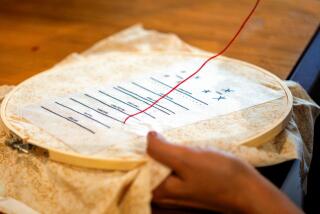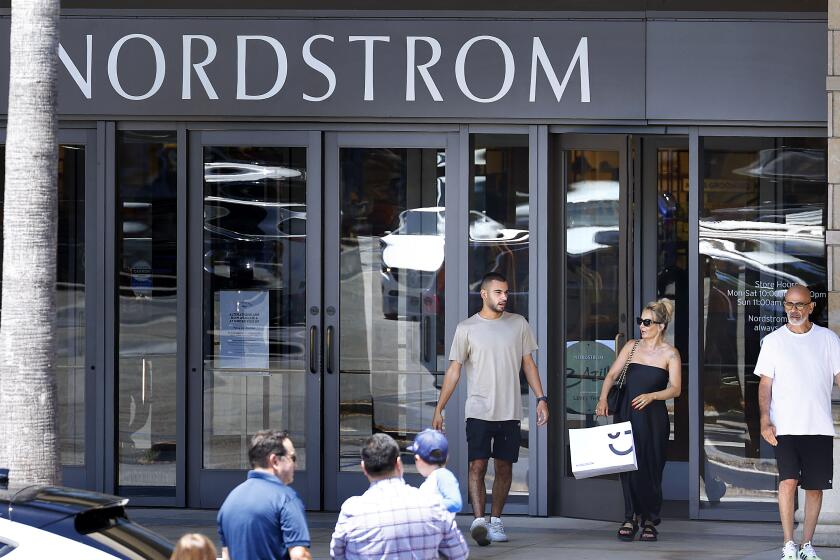Garment Shop Threads Its Way as a Co-op
- Share via
OAKLAND — “All I knew was to sit down at my machine and sew,” Ruth Pereira, 58, recalls. “I wanted to come in at 8, go home at 4. I said ‘no’ to being a supervisor, ‘no’ to responsibility.”
That was 18 months ago, before her employer, Sierra Designs Inc., decided to close its Oakland Manufacturing plant and contract its manufacturing elsewhere. But workers there decided to fight, and though they lost the battle against closure, they won the larger war. On April 1, they celebrated the first birthday of their Rainbow Workers Co-op, the only worker-owned garment shop on the West Coast.
In the beginning, said Pereira, who is a member of the Co-op board, the workers had no idea of forming their own business--they just hoped to change their employer’s mind and save their jobs. Sierra Designs employed about 75 people to manufacture tents, jackets and other outdoor equipment.
Mainly they were minority women--Chinese, Mexican, Filipino, black--middle-aged and frightened. Many spoke no English.
“Some people had been here 16 years, and they had become passive,” recalled Betty Chisolm, who is president of the Co-op board of directors. “The job was always expected to be there. They found that was not so.”
Chisolm, 49, grew up in Mississippi, one of 14 children. “I’ve always been hot-headed,” she said. Twice before she had quit her job, but this time, she said, “I got too old to quit jobs.” She remembers that when the plant closed down, “some were crying. I myself got angry.”
With the help of the Oakland-based Plant Closures Project, a coalition of labor, religious and community groups that monitors business closings, Chisolm and her fellow workers launched an aggressive campaign to reverse the company’s decision to close. They enlisted the support of community groups and of the Oakland City Council, launched a post-card campaign and formed an independent union with Chisolm as president.
In 1984, on the Saturday after Thanksgiving, traditionally the first day of Christmas shopping, they picketed the firm’s stores in Berkeley and San Francisco, and later set up lines around the company’s other retail stores. Ruth Pereira said that when she joined the pickets, she worried about what her sons would think. “I don’t have their college education; I thought they would be ashamed of me,” she said. “But they were proud. They made scrapbooks and tapes.”
The women threatened to take their case to the stockholders’ meeting of Sierra Designs’ parent company on Dec. 11, but “at 11 p.m. on the night of the 10th, we came to agreement with them,” said. “It was nerve-racking, but kind of fun.”
Although they had not managed to keep the factory open, they did win better severance pay and health benefits after its closure and most importantly, crucial help from the company in setting up a cooperative sewing shop.
The idea for the Co-op came originally from the Plant Closures Project. Chisolm said “Sierra Designs grabbed on to it” as a way to settle a labor dispute, “and then we did, as a way to have a job.”
Sierra Designs funded a feasibility study and gave 10% of the proceeds from a January sale to the workers. The Co-op got $30,000 out of that. The company gave or sold at reduced cost some of its equipment, and also guaranteed $450,000 work a year to the Co-op for a minimum of three years.
At Retirement Age
Not all the workers chose to get involved with the new enterprise. “A lot of them were at retirement age anyway,” Betty Chisolm explained, adding that “some of the younger ones decided to go for retraining.” In the end, 33 took the plunge. Most of their $1,000 membership dues were paid for out of the sale proceeds.
The Co-op is housed in a warehouse near San Francisco Bay, a 13,000-square-foot space lit by skylights. Ruth Pereira recalled with pride how she and her fellow workers got the place in shape, building a partition, assembling sewing tables. “There were women on ladders putting up Sheetrock--they’d never done that, they had husbands who did that sort of thing,” she said. “We never were women with hammers and screwdrivers before.”
She looks back on the year with pride. “Before, I used to listen, I didn’t get involved. Now I listen and I get involved,” she said. “Being an owner, it is frightening, but I love it. It has surprised me, the things that were accomplished.”
Still, it has not been easy to make the shift from being an employee to being both worker and owner at the same time. Co-op members continue to get training ranging from seminars on their responsibilities as board members, to how to read a financial statement, to upgrading their production skills.
‘Money Now’
“A lot of people want to see money now, not down the road,” Chisolm said, adding that before they were operator/owners, they collected a paycheck without considering profit and loss. “They were content with their hourly base, but now I need them to give me support, to be managers,” she said. Workers, including the officers and board members, are paid a base rate of $4.25 an hour (75 cents less than they were making before), plus piece rate incentives. By next year, Chisolm hopes the Co-op will begin to make a profit for its members to share.
Before that can happen, though, new kinds of effort are required, and Chisolm said, “if you have made the same jacket for 25 years, you think, ‘What do I need this for?’ ” when you are presented with something new to work on. She acknowledged, “No one wants to accept change. But we have to diversify.”
In January, the Co-op hired Barbara Shumaker as plant manager to make the necessary changes.
Shumaker, who started working as a sewing machine operator at 15, later moved into management and also finished four years of engineering schooling. Before coming to the Co-op, she was free-lancing as a consultant.
Shumaker has brought in considerable new business, reducing the Co-op’s dependence on Sierra Designs from 90% to 60%. New products include swim wear, dresses, nightgowns, children’s rainwear and sportswear. “Sierra Designs have been very good to us, very cooperative,” she said, but emphasized that if the Co-op is to survive, it must expand and diversify.
In their first year, the Rainbow Co-op Workers received grants and loans of $250,000 from city, state, private and church sources. This year, they’ll need considerably less. Shumaker is looking for $25,000 to $50,000 to expand the shop. Said Chisolm, “We don’t want to get so dependent on outside money that we won’t make it on our own.” First year sales totaled $800,000. Their sales goal is $1 million this year; at $800,000, they’ll break even.
The workers are being hired steadily--ideal size is 100 sewing machine operators, according to Shumaker. After six months, workers become eligible to join the Co-op; after a year they must either join or leave. Chisolm said that if they don’t have the necessary $1,000, the Co-op will lend it to them.
Shumaker puts in 15 or 16 hours a day, seven days a week, an example Ruth Pereira said is not lost on the workers.
Right from the start, Shumaker said she didn’t hide the problems the shop was having, and worked hard at “getting people to think like business owners.” At the same time, Co-op members get no special privileges because they own the place. Pereira recalled that when Shumaker told them that during working hours she didn’t intend “to look at us as owners, but as workers, that took us back. But then we started thinking, ‘She is right.’
“We are the owners, but we don’t come in and say this is my place: We come in as workers. We work harder now we are the bosses, we come in on Saturdays, and work after hours because this is ours. We wouldn’t do that for another company.”
More to Read
Inside the business of entertainment
The Wide Shot brings you news, analysis and insights on everything from streaming wars to production — and what it all means for the future.
You may occasionally receive promotional content from the Los Angeles Times.










